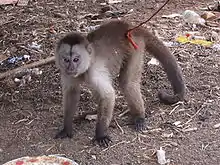| Chestnut capuchin | |
|---|---|
 | |
| In French Guiana | |
| Scientific classification | |
| Domain: | Eukaryota |
| Kingdom: | Animalia |
| Phylum: | Chordata |
| Class: | Mammalia |
| Order: | Primates |
| Suborder: | Haplorhini |
| Infraorder: | Simiiformes |
| Family: | Cebidae |
| Genus: | Cebus |
| Species: | C. castaneus |
| Binomial name | |
| Cebus castaneus I. Geoffroy, 1851 | |
The chestnut capuchin or chestnut weeper capuchin (Cebus castaneus) is a species of capuchin monkey from northeastern Brazil, southern Guyana, Suriname, and French Guiana.[2]
Taxonomy
It was described in 1851 as a subspecies of the wedge-capped capuchin (C. olivaceus). However, a 2012 study found grounds to at least tentatively recognize it as a distinct species.[3] The American Society of Mammalogists, IUCN Red List, and ITIS all follow this classification.[2][4]
Distribution
It is found in northeastern Brazil, southern Guyana, and most of Suriname and French Guiana. It inhabits the uplands of the Guiana Shield north of the Amazon River, east of the Rio Negro, limited on both sides by the Branco River, and from here ranges north, east of the Orinoco and Ventuari rivers, to Guyana. Its range still remains poorly known.[1]
References
- 1 2 Mittermeier, R.A.; Boubli, J.P.; Lynch Alfaro, J.W.; Laroque, P.O. (2021). "Cebus castaneus". IUCN Red List of Threatened Species. 2021: e.T43941A191707135. doi:10.2305/IUCN.UK.2021-1.RLTS.T43941A191707135.en. Retrieved 6 December 2021.
- 1 2 "Explore the Database". www.mammaldiversity.org. Retrieved 2021-12-06.
- ↑ Boubli, Jean P.; Rylands, Anthony B.; Farias, Izeni P.; Alfaro, Michael E.; Alfaro, Jessica Lynch (2012). "Cebus Phylogenetic Relationships: A Preliminary Reassessment of the Diversity of the Untufted Capuchin Monkeys". American Journal of Primatology. 74 (4): 381–393. doi:10.1002/ajp.21998. ISSN 1098-2345. PMID 22311697. S2CID 12171529.
- ↑ Boubli, J.P.; Urbani, B.; Lynch Alfaro, J.W.; Laroque, P.O. (2021) [amended version of 2020 assessment]. "Cebus olivaceus". IUCN Red List of Threatened Species. 2021: e.T81384371A191708662. doi:10.2305/IUCN.UK.2021-1.RLTS.T81384371A191708662.en. Retrieved 4 September 2022.
